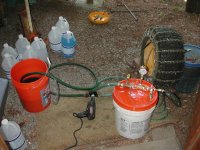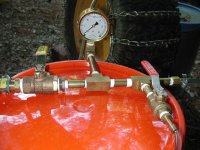Anonymous Poster
New member
- Joined
- Sep 27, 2005
- Messages
- 0
Hi All,
I am happy to report success at my first attempt to load tires with windshield washer fluid. Also have a couple data points that may be of interest. Decided to start a new thread on this…hope that is OK…
The little drill-operated pump that I got for under $6 worked real nice. I used a pressure gage to check the output pressure if the little guy, and it turned out to be 23 PSIG when the output was totally blocked. I was surprised as for some reason I was expecting it to be much lower.
At first I was going to try to figure a way to put the WW fluid into the valve stem, through a small tube, with some airspace around it, so as the fluid went in the air would come out, and it would be a simple filling procedure, that required no stopping. Bird suggested that the hole in the valve was quite small and that doing this would likely be impractical. Turned out that he was right.
After seeing that the pump output pressure was pretty good, I made a set up from some valves and fittings that I had lying around. I used two valves and also incorporated a PSI gage. One valve shuts off the flow from the pump, and the other allows the air from the tire to be expelled. This second valve outputs into a piece of tubing that returns any liquid that may come out with the air back to the five gallon bucket that holds WW fluid to be pumped into the tire. A piece of plastic tubing carries the WW fluid to the tire valve stem. This tubing just slips over the end of the valve stem, and is held in place by a small hose clamp.
First thing I did was use an old MTB tire [bicycle tire] for test purposes, and it filled just fine. So I decided to get the garden tractor and try filling the rear tires with WW fluid. I used vinyl tubing to carry the fluid from the valve assembly I made to the tire, and it was a rather long piece. This caused some pressure drop, but this was not an issue. What I found was that there was about a 4 PSI drop between the pressure gage and the tire. I know this because when I shut the valve from the pump, the pressure dropped about 4 psi.
I ran the drill pump with a little 1/4 inch drill that I normally never use for anything because it is so small. It is 1200 RPM. It was totally satisfactory.
For no specific reason, I decided to shut off the pump and close the feed valve when my pressure gage reached 15 PSIG. AT that point I opened the bleed valve and let WW fluid, and then air drain back to my source bucket. On the first tire, I did this procedure three times, but the third time a huge amount of WW fluid was returned. ON the second tire, I only pumped twice, and that was enough to totally fill the tire.
All in all, I was surprised how easy it was to fill these tires. I am sure it would be just as easy to fill the tires of my new Kubota B2910 when it gets here. Probably easier, as I had to remove the tires from the little garden tractor, since the valve stems were on the inside and I had to use some long nosed pliers to remove the guts….
I took a couple photos of my setup, but can't post them now…kind of sleepy!
Bottom line is I am really amazed at how easy it was to make this setup and get the fluid into the tires. Total cost probably will be less than $50 to fill both rear tires on the B2910. Sure beats the cost the dealer would charge.
All in all I am really satisfied with how this worked. I would encourage others to fill their own tires if they are so inclined…it is really not hard to do….
Bill Macher in PGH PA
I am happy to report success at my first attempt to load tires with windshield washer fluid. Also have a couple data points that may be of interest. Decided to start a new thread on this…hope that is OK…
The little drill-operated pump that I got for under $6 worked real nice. I used a pressure gage to check the output pressure if the little guy, and it turned out to be 23 PSIG when the output was totally blocked. I was surprised as for some reason I was expecting it to be much lower.
At first I was going to try to figure a way to put the WW fluid into the valve stem, through a small tube, with some airspace around it, so as the fluid went in the air would come out, and it would be a simple filling procedure, that required no stopping. Bird suggested that the hole in the valve was quite small and that doing this would likely be impractical. Turned out that he was right.
After seeing that the pump output pressure was pretty good, I made a set up from some valves and fittings that I had lying around. I used two valves and also incorporated a PSI gage. One valve shuts off the flow from the pump, and the other allows the air from the tire to be expelled. This second valve outputs into a piece of tubing that returns any liquid that may come out with the air back to the five gallon bucket that holds WW fluid to be pumped into the tire. A piece of plastic tubing carries the WW fluid to the tire valve stem. This tubing just slips over the end of the valve stem, and is held in place by a small hose clamp.
First thing I did was use an old MTB tire [bicycle tire] for test purposes, and it filled just fine. So I decided to get the garden tractor and try filling the rear tires with WW fluid. I used vinyl tubing to carry the fluid from the valve assembly I made to the tire, and it was a rather long piece. This caused some pressure drop, but this was not an issue. What I found was that there was about a 4 PSI drop between the pressure gage and the tire. I know this because when I shut the valve from the pump, the pressure dropped about 4 psi.
I ran the drill pump with a little 1/4 inch drill that I normally never use for anything because it is so small. It is 1200 RPM. It was totally satisfactory.
For no specific reason, I decided to shut off the pump and close the feed valve when my pressure gage reached 15 PSIG. AT that point I opened the bleed valve and let WW fluid, and then air drain back to my source bucket. On the first tire, I did this procedure three times, but the third time a huge amount of WW fluid was returned. ON the second tire, I only pumped twice, and that was enough to totally fill the tire.
All in all, I was surprised how easy it was to fill these tires. I am sure it would be just as easy to fill the tires of my new Kubota B2910 when it gets here. Probably easier, as I had to remove the tires from the little garden tractor, since the valve stems were on the inside and I had to use some long nosed pliers to remove the guts….
I took a couple photos of my setup, but can't post them now…kind of sleepy!
Bottom line is I am really amazed at how easy it was to make this setup and get the fluid into the tires. Total cost probably will be less than $50 to fill both rear tires on the B2910. Sure beats the cost the dealer would charge.
All in all I am really satisfied with how this worked. I would encourage others to fill their own tires if they are so inclined…it is really not hard to do….
Bill Macher in PGH PA

